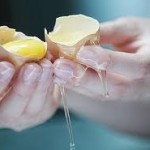This last summer Europe had an E.Coli outbreak, now thought to be from sprouts, but the US major source of food borne illness continues to be Salmonella.

Raw eggs should be considered contaminated
Food poisoning cases from Salmonella have increased by ten percent in recent years according to the Centers for Disease Control and Prevention (CDC). While all food-borne illness cases dropped over the last decade Salmonella has steadily increased. In 2010 there were 4,200 hospitalizations and 68 deaths from nine different food-borne diseases, and Salmonella was responsible for most of them, including 23 of the deaths.
Last year one of the largest outbreaks of food borne illness involved Salmonella-tainted eggs, which may have been responsible for over 50,000 cases. The Food and Drug Administration did put in place new rules to reduce the illness caused by Salmonella.
The Salmonella from eggs comes from the hens that lay them- thus the eggs are contaminated when they come from the grocer. The new rules for egg producers are designed to reduce this issue.
The most famous outbreak of Salmonella was from Typhoid Mary – a house servant who was infected with a form of Salmonella that she passed on to her employers. Her famous dish was peach ice cream. But the ice cream became the source of the issue. Mary passed her salmonella to a number of families, but refused to give up her job, or keep her hands clean- for that she spent the last part of her life in an institution. Still, we hear her peach ice cream was to die for.

Typhoid Mary was famous, or infamous, for her peach ice cream.
The biggest issue with bacteria and food safety is cross-contamination. This means that the bugs from one food are passively transferred to another food, where they grow. For example, if you wash some raw chicken in the sink, where there is a cutting knife- you can contaminate that knife with bacteria. Then you clean the knife with not enough to get rid of bacteria and use the knife to cut some cooked eggs. The eggs are a perfect growing source for bacteria- so while the eggs are sitting out- the bacteria you contaminated with them are growing like crazy. You eat the eggs, and get sick from the chicken (so the chicken came first). Lesson here; do not wash raw poultry in the sink – no need to. Anytime you handle any raw meat, or eggs – treat everything they touch like it just came out of the toilet.

The cutting board, knife, and your hands need to be carefully washed after handling raw chicken
When you handle raw meat, be sure to not use the same cutting board when the meat is finished cooking. If you own one cutting board- after having raw meat be sure to wipe it down with a solution of Clorox.
If you use a knife, or fork, or any instrument with raw meat- wash that utensil carefully. Essentially, consider raw meat and raw eggs as contaminated, and anything it touches – you, your clothes, your cooking utensils, your cutting boards, and your knives – as contaminated. When people get sick from the bacteria from the raw meat it is typically because of cross-contamination to other foods.
Refrigerate all foods promptly. If food is at room temperature for more than two hours it may not be safe to eat. The bacteria that cause food poisoning typically do not produce an odor or change the texture of the food. Think about this the next time someone wants to invite you to a buffet.
Make certain that your refrigerator is kept at 40 degrees or cooler, and that there is plenty of room to circulate the air in the refrigerator. Keep the freezer at or below 0 degrees F.
Wash your hands carefully – I use a special soap that is made from primarily alcohol, the same type of soap we use before scrubbing in the operating room. You can purchase this from most stores, a brand such as Purell. Always wash after handing raw meat, poultry, fish, shellfish, produce, or raw eggs. Scrub and lather for at least for twenty seconds after handling any raw meat.
Wash all fruits and vegetables under running water before eating or cooking them. Use a vegetable brush to scrub melons and cucumbers – then dry with a paper towel. Consider the vegetable brush contaminated- so keep it clean.
It is easier to throw out food than to be sick. Don’t be afraid to toss out any food that you are suspicious of. Food that sits out for more than two hours- get rid of it.
